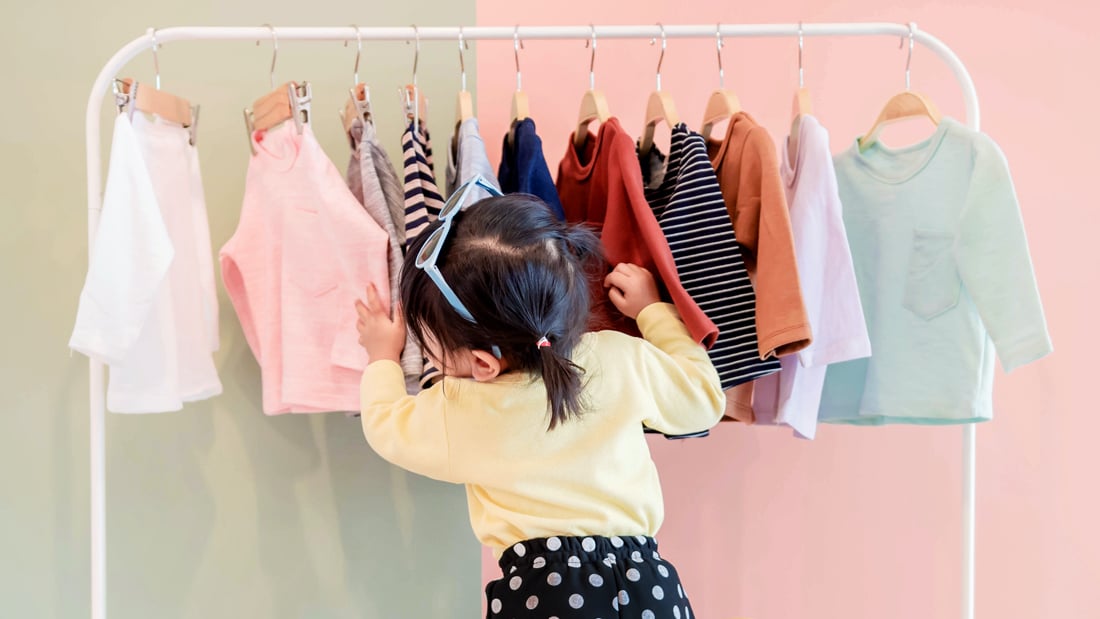Dressing Tips and Tricks for Parents of Young Children
Dressing can be a daily struggle when young children are in a phase of craving independence, but not quite being capable yet. It can be hard to determine when to let them struggle, when to do it for them, and when to let them wear an inside out shirt over a tutu and two different shoes all day. Based on developmental age tables, most children will be able to dress and undress themselves independently, including choosing appropriate clothing and adjusting it, by 5 years old (Linder, 2008). This can be a hard outcome to see when your four-year-old gets trapped inside their sweatshirt as they try to put it on, but there are many small, developmental steps that occur within dressing before reaching the point of independence.
With many skills children learn, they are able to un-do, before they are able to do. It is much easier to knock down a block tower than it is to build one. This is true for dressing as well, and as most parents know, some of the first dressing skills involve removing gloves, socks, and hats. According to North Carolina Early Learning and Development Progressions (2015), it is expected that a child will be able to independently undress themselves by 32 months old. Often, children are inherently motivated to learn to undress so they can roam their home in their natural state. The trickier part can be helping your child to find the motivation for learning dressing skills, which can be challenging for you child, and frankly, less rewarding. One way to help your child learn dressing skills in a way that is less intimidating, easier to accomplish, and more fun, is to have them practice dressing on their stuffed animals. Having clothing that is slightly too large, but not excessively oversized, makes dressing tasks easier. Using old baby or toddler clothing to put onto Teddy can be silly, fun, and teach things like managing the head hole vs. the sleeve hole. You can also have your child complete relay races in which they dress a stuffy, themselves, or even you in a race against the timer. To add even more fun to this activity, hide the clothing items around your home and turn it into a scavenger hunt.
Once your child is successfully dressing themselves in fun and playful environments, consider challenging them to dress themselves in the morning. It can be helpful to have your child’s clothing in drawers that are easy for them to access, with a picture on the outside of each drawer indicating what type of clothing is inside. If you are feeling crafty, you can create a visual schedule that shows your child what order to select and put on clothing with pictures that correspond to the drawers. Having this complex activity broken down into simple steps helps your child to begin the task and move through it more independently. Some children enjoy having the motivation of a timer to complete this task, while others will find a timer to be frustrating. It will be important to remember that somedays your child will need more help than on other days, and that the different items and types of clothing require different levels of assistance. Typically, children are able to put on pull-over t-shirts independently first, then underwear and elastic waist pants, then socks and shoes, lastly successfully closing fasteners (around 54 months) (North Carolina Early Learning and Development Progressions: Birth to Five, 2015).
The final step of dressing, and often most stressful, is putting shoes on before going outside. Parents frequently find themselves having to make the decision of whether to wait for their child to try to put on their own shoes, and end up 20 minutes late, or whether to just do it for them and be on time (or at least closer). The demands of life will sometimes mean choosing to do it for them, but there are ways to make this process quicker and more painless for those days when you have the minutes to spare. Consider keeping your child’s favorite going-out shoes in a separate bin by the door, to only be used for trips beyond the home. This will help your child with the first step of knowing which shoes to grab. To help your child put their shoes on the correct feet, get a large sticker, cut it in half, and put the halves in the interior sole of the child’s shoes, so when they look into the shoes positioned correctly, the stickers line up to make the image. For choosing the best fastening method for your child’s shoes, considered that they should be able to pull elastic laces tight by 33 months, close Velcro fasteners on shoes by 54 months, and tie shoe laces by 6-7 years old (North Carolina Early Learning and Development Progressions: Birth to Five, 2015).
Now your child is looking good, fully dressed, and ready to head out the door and have fun! Dressing independently is one of the most important self-care skills that children learn to do in the first five years of life. It offers children a sense of control over their day, and the opportunity for creative expression. While there are many small steps and phases within dressing, also meaning many opportunities for hitting snags, children are often naturally motivated to accomplish dressing tasks, and feel a sense of pride when they do so. When snags do occur, the strategies in this article provide some ideas for how to overcome. The most important takeaways are to keep it fun, simplify when possible, and practice during times of play.
If you find that dressing is not going how you expected it to, or that your child is not meeting the expected developmental norms for dressing, and the strategies provided here are not working out as planned, consider seeking support from a trusted therapist. At Carolina Pediatric Therapy, we have a team of occupational therapists who are prepared to walk beside you on your journey. With or without shoes. We’ll get to that part together.
Sources:
Linder, T. W. (2008). Transdisciplinary Play-Based Assessment (2nd ed.). Baltimore, MD: Paul H. Brookes Co.
North Carolina Early Learning and Development Progressions: Birth to Five. (2015).
Want to know how a Therapist can Help?
Call (828) 398 0043 or click on the schedule button.



